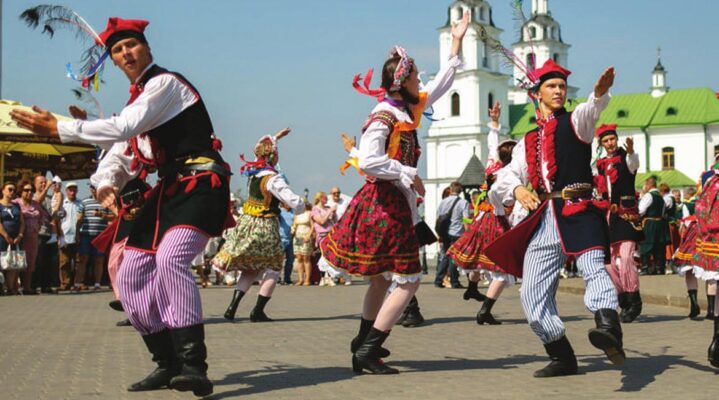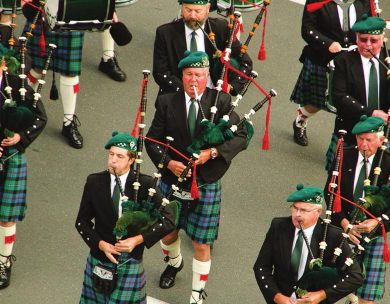
Wherever you Go, take Traditions with You
How important are our traditions to us? I think the answer should be, very important. When you are an expat, you seem to be even more concerned about your mother country’s traditions and culture. As a born Swede, I am very proud of ours, as I think most people are. As well as the St Lucia celebration, I’m keen on celebrating Easter with traditional Easter dishes, Easter eggs, etc., and of course Midsummer.
When you dance around the decorated poles singing funny songs like “Små grodorna” (The Small Frogs) jumping up and down with the young kids and making a flower wreath to wear on your head and the picking of seven summer wild flowers to put under your pillow to dream about your future husband.
These are the three main celebrations that Swedes look forward to celebrating, even if we today, with huge immigration, have to experience them somewhat attenuated. A while ago, I had the pleasure to attend the St Andrew’s Ball at the Amari Watergate Hotel in Bangkok.

This was the first time I had ever heard about this exuberantly fun and special ball, and here we can really talk about traditions. Our British hosts showed us a great deal of theirs including costume, music, dances and food. The St Andrew’s Society was founded 125 years ago in 1890. Since then there have been 95, so called Chieftains. A Chieftain is the leader of a clan.
Ancient… enigmatic… colourful… complex… all of these words describe the clans of Scotland which are part of this country’s compelling historical journey. The Scottish clan system plays a huge role in their culture and tradition. Today, Scots around the world are still committed to their clan heritage and very proud of it.
The system was established in the 11th and 12th century but there are signs of their existence going back to the 6th. The word “clan” comes from the Gaelic word “clann” meaning “family, offspring children”. The original clans of Scotland were basically big family groups. The names were, in the beginning, tied to specific areas, called “clan territories”.
Loyalty and devotion are two of the most important words to clans. In 1746 a Scottish rebellion was defeated at the Battle of Culloden and the clan system was almost wiped out. In the 19th century they saw a growing popularity and revival of their clans. To the clan system the distinctive Scottish tartan is closely tied. In tartans you will find many different colours and patterns.

The original clans of Scotland were basically big family groups. The names were, in the beginning, tied to specific areas, called “clan territories”.
Just to mention some examples; the “Donald” tartan comes in dark blue, green, red and some yellow. The “Stewart” has the colours red, white and green and the “Forbes Ancient” includes the colours dark blue and green. In the late 1700s the tartans began to be a clan symbol. Kilts themselves were seen as early as 1500 as a kind of highland dress and they looked quite different from today’s kilts.
A clan today is a legally recognised group in Scotland. Clan Chiefs are considered noblemen. This is just a short and very simple description of a Scottish clan. Let’s return to the St Andrew’s Ball. We were greeted with classic drinks like Bloody Mary’s and Margaritas, along with of course beer and wine.
The British Club Pipe Band played traditional music to welcome the guests. The band’s tutor and Pipe Major Keith Walker is also a piping instructor at Vajiravudh College in Bangkok, which has a large pipe band with more than 50 pipers. This pipe band is available to play in uniform at British Club functions, private events, weddings, etc. They all wear the Royal Stewart
tartan.
If you would like to know more about them, go to facebook.com/ Wherever you go, take traditions with you BritishClubBangkok PipeBand. We sat down at beautifully decorated tables with flowers and, of course, a bottle of Scotch whisky was placed in the middle of the table. The menu included several great dishes, but I will only mention Haggis, bashed neeps and champit tatties.
I had no idea what Haggis was, but now I can tell you: it’s a savoury pluck (heart, liver and lungs) minced with onion, oatmeal, suet, spices and salt mixed with a stock. Do you think it sounds delicious? I’m not sure I would have eaten it if I would have known the ingredients …… though I had to admit it tasted quite good. I even saw some of the guests pouring a few drops of the whisky on it.
Before dinner was served, we stood all up and listened to the national anthems, the Thai and the British. There was the Chieftain’s speech and a message from the First Minister of Scotland, Mrs Selkirk Grace, to be seen and heard on the big screens. We had the pleasure to enjoy dances performed by the Gordon School of Dancing and listen to the Bahookie band during dinner.
“Traditions give us a base to stand on and it’s important that we forward them to our young generation.”
The Big “Bahookie” sound is a unique blend of rock, dance and traditional Celtic music. This was the second time the band came to play at the St Andrew’s Ball in Bangkok. If you want to learn more about this famous band check out on www.bahookie.org I also would like to mention some words about The Gordon School of Dancing. This school is very well known, not only in Scotland, but also in many other parts of the world.
The students have performed in Spain, France, Italy, Turkey, Canada, Trinidad, USA and China, just to mention a few, but the highlight of the year is the St Andrew’s Ball in Bangkok. The pupils from such a young age as 2 are taught many genres of dance. “I like to think that my pupils breathe new life into traditional Scottish dancing while remaining true to a long and well respected tradition,”
Mrs Robina says who is the leader and owner of the Montrose School of Dancing. Robina and her husband Norman have been returning to Bangkok with the dancing school for the past 7 years. More than 50 different dancers have enjoyed the trip of a lifetime to Bangkok, Robina says.
Robina is honoured to be Deputy Lieutenant for Angus and both her and her husband Norman, organised Queen Elizabeth’s 80th birthday celebration at Balmoral Castle, among many other events. This couple lead a very busy life with dancing and royal duties for Robina, and piping and breeding pedigree highland cattle for Norman.
Norman is also a fellow of the Guild of International and Professional Toastmasters. We had the great pleasure to enjoy several dances during dinner and see different tartans. At last I’d like to tell you little history about the Pipers. It’s not easy to find out about the Bagpipe in Scotland. It seems like the Scottish people have always played them. Some people say it started in the 13th or 14th century.

It is most possible that the Scottish piping traditions came up out of England. In the Lowlands, here the hereditary piper seems to have been born. Every town had a piper and the role of town piper was passed from father to son. By 1700, Reverend David Kirkwood advised that “Pipers are held in great request, so that they are train’d up at ye expense of grandees and have a portion of land assign’d such a man’s piper.”
Now that you have received this very brief information about Scottish traditions, I can only recommend that you take part at the next St Andrew’s Ball. It was great fun and everybody enjoyed the dances, since even the beginners joined in and had fun. I will, for sure, attend the next ball.
Traditions give us a base to stand on and it’s important that we forward them to our young generation. How often have you started a tradition like eg waking your child up with a breakfast tray and a cake, candles and flowers when she/he is having a birthday? If you, for whatever reason, leave it out one year, well when you get to hear it…
If you go ice skating in winter with your children and then come back home, serve them hot chocolate with whipped cream and once change it into another beverage, well I’m quite sure you will hear the question “why don’t we get our hot chocolate mom”?
If you, are in the first years of your marriage, get spoilt with small, presents eg from Cartier and you don’t receive them later on, you will, for sure miss it, but maybe not asking for them? A tradition that could stop for other reasons…
I’m also sure, that even when your children are grown up and Santa isn’t coming at Christmas anymore, in the bottom of their hearts, they miss him.I can only say “Long live the traditions – let us keep them!”



